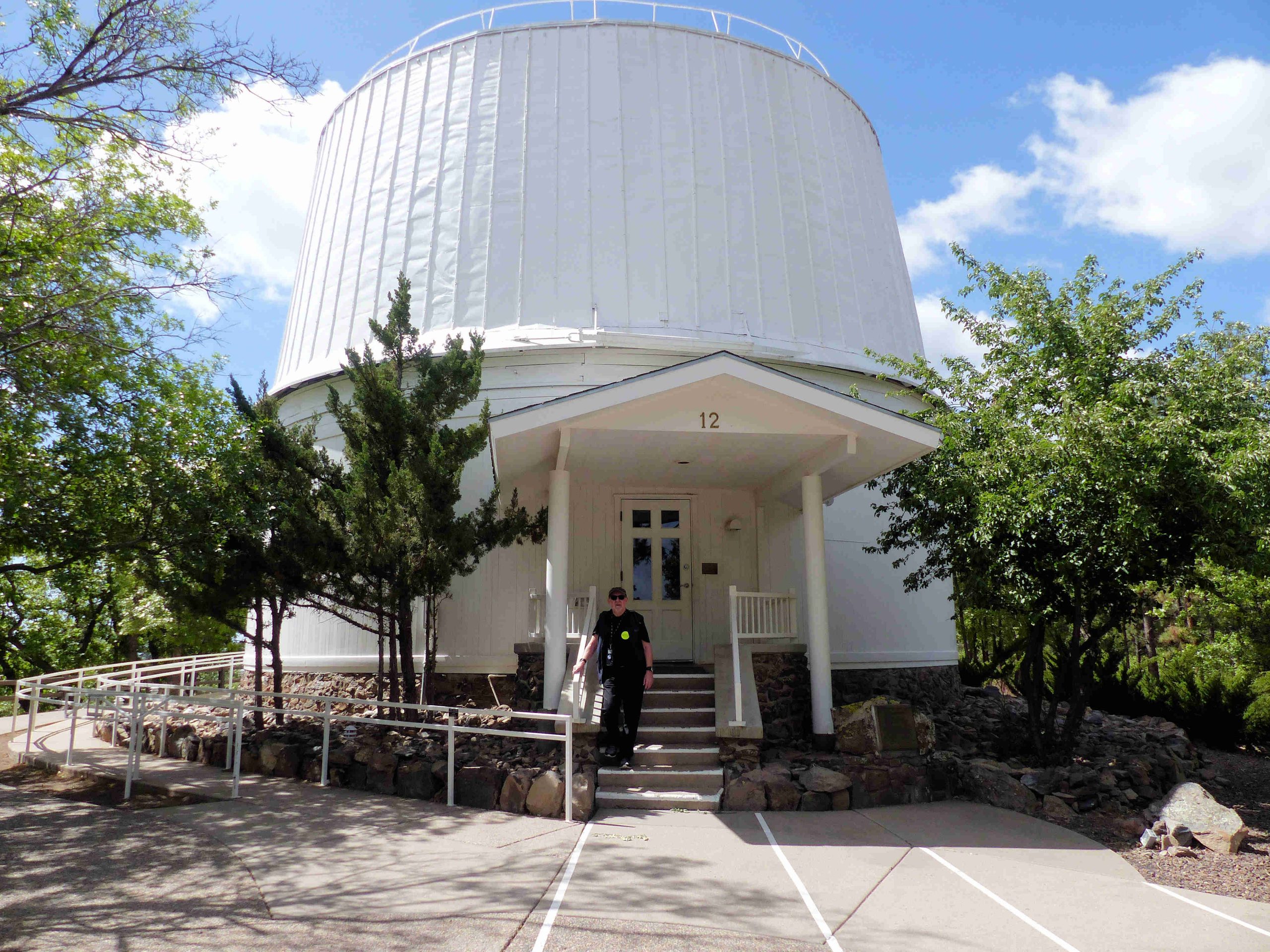Lowell Observatory, Flagstaff, Arizona
This year, on a trip to the United States, I visited Lowell Observatory in Arizona.
It has everything you could wish for in an astronomical centre.
The setting is beautiful and there are big telescopes to see.
The site is steeped in celestial history. Pluto was discovered here.
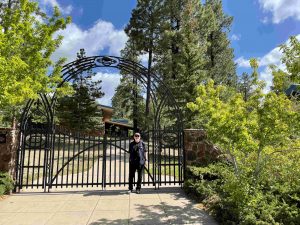
Lowell Observatory entrance. Photo: Dennis Ashton
And as a wonderful bonus, the staff at Lowell run regular observing nights.
You can use state of the art telescopes to view the clear Arizona skies.
It really is one of my favourite places on Earth.
Percival Lowell
Percival Lowell was born in Boston, Massachusetts in 1855.
He became a wealthy businessman and authored several books about his world travels.
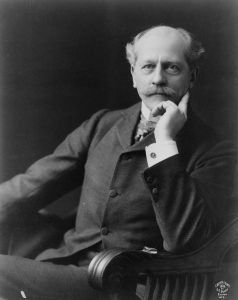
Percival Lowell. Photo: James Edward Purdy
He became interested in astronomy, particularly in the planet Mars.
From the 1890s this fascination took over his life.
Lowell had studied the work of Italian astronomer Giovanni Schiaparelli.
Schiaparelli had published maps of Mars which seemed to show canals criss-crossing the red planet.
The ‘canals’ implied there was intelligent life on a neighbouring world.
For Lowell it was an intriguing prospect that warranted serious research.
In 1894 he chose to build an observatory in the hills above Flagstaff, Arizona.
The chosen site became Mars Hill.
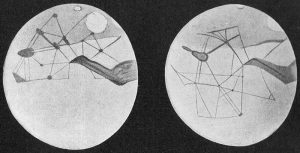
Lowell’s Martian ‘canals’. Public Domain
Over 15 years, Lowell observed Mars and published his drawings of the red planet.
They showed system of straight waterways.
Lowell was convinced that intelligent beings on Mars were attempting to irrigate their increasingly arid world.
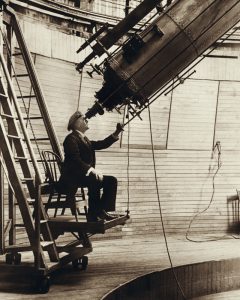
Percival Lowell at the Clark Telescope
Photo: lowell.edu
Of course, the features Lowell drew were not canals at all.
Influenced by Schiaparelli, he had misinterpreted natural markings on Mars.
But his work inspired science fiction writers.
H G Wells classic ‘War of the Worlds‘, published in 1898, is based on a the idea of a dying Martian civilization.
However Lowell was to be proved correct in another of his projects.
He was convinced that a ninth planet lay beyond Neptune.
In 1906, Lowell began a search for ‘Planet X’.
It was a search that would end in success but Lowell would not live to see it.
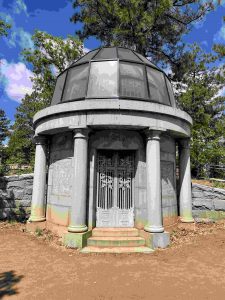
Lowell Mausoleum. Photo: Dennis Ashton
Percival Lowell died in 1916, aged 61.
He is buried on Mars Hill in the grounds of his beloved observatory
Clyde Tombaugh and the discovery of Pluto
In 1929 young astronomer Clyde Tombaugh began work at Lowell.
His project was to find Planet X, a world beyond Neptune.
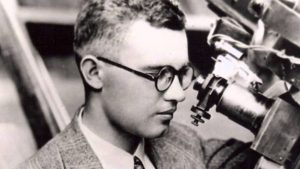
Clyde Tombaugh. Photo: NASA
He took photographs of the same part of the sky on different nights
He then compared the images to see if anything had moved, changed position.
To do this, he used a blink comparator.
This device switched quickly from one image to the next and back again.
An unknown planet would reveal itself by its change of position.
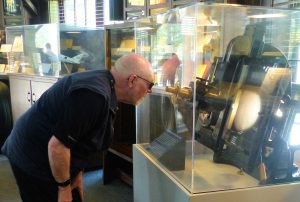
Dennis and the blink comparator. Photo: Dennis Ashton
On February 18th, 1930, Tombaugh discovered such an object.
He had found Pluto.
It was a discovery with which he and the Lowell Observatory would be linked forever.
My visit to Lowell
I visited Lowell on a warm sunny day in June .
The campus is high on Mars Hill, a short, pleasant drive from downtown Flagstaff.
The observatory domes are set among ponderosa pines, a wonderful place to stroll around.
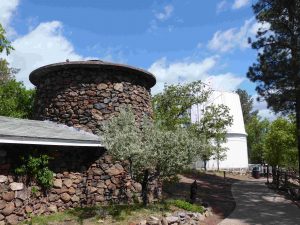
Lowell Observatory. Phot: Dennis Ashton
The Rotunda Museum is a great starting place for exploring Lowell.
Exhibits cover the history of the museum.
They include Tombaugh’s blink comparator and artifacts from Lowell’s observation of Mars.
It also has a section devoted to Vesto Slipher, whose work lead to the discovery of the expansion of the universe.
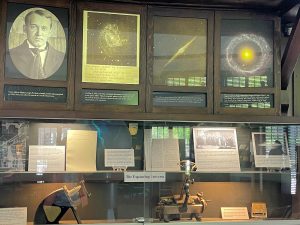
Vesto Slipher exhibits. Photo: Dennis Ashton
Maps used in the Apollo programme and a Space Shuttle wheel represent Lowell’s contribution to space exploration..
I then moved on to the Clark telescope, whose dome is the first thing you see when arriving at Lowell.
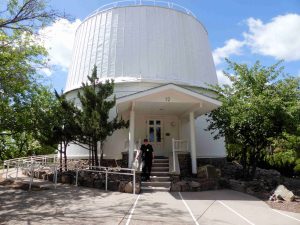
Clark Telescope dome. Photo: Dennis Ashton
On entering the observatory, you can feel its history around you.
Percival Lowell used this 24-inch refractor to study the surface of Mars.
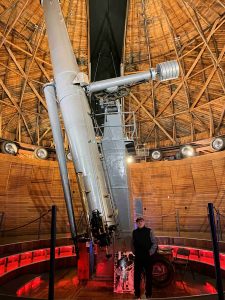
Clark Telescope. Photo: Dennis Ashton
In the 1960s, astronomers would use it to map the Moon for Apollo astronauts.
A lovely touch is that the dome roof revolves on a set of Ford car tyres!
In chatting to people, I missed the tour of the Pluto dome.
It was no problem because I intended to return that evening for an observing session.
This proved to be a wonderful experience and will be the subject of my next blog.
Lowell’s current research
Lowell Observatory is an active research institution.
Its research topics include galaxy structure and characteristics of stars.
It keeps Lowell’s legacy alive by exploring the Solar System and searching for planets orbiting distant stars.
That research is carried on at Lowell and at a new telescope.
The Lowell Discovery Telescope is near Happy Jack in Arizona.
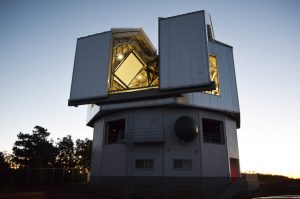
LDT observatory. Photo: lowell.edu
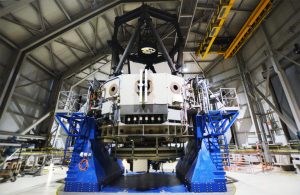
Discovery Telescope. Photo: lowell.edu
The 4-metre mirror makes the LDT the fourth biggest in the USA.
Its instrumentation means it is one of the most powerful in the world.
Research at the Discovery Telescope enhances the work of Lowell.
A Sheffield Connection
I explained to observatory staff that I owe a debt of gratitude to Lowell.
I visited the observatory back in the 1990s.
At the time I was involved in setting up Star Centre, an astronomy base at Sheffield Hallam University.
One of the Lowell astronomers wrote a letter of support for our venture.
That note, along with others from people like Russian cosmonaut Valentina Tereshkova, helped us obtain the funding for Star Centre.
The project ran for ten years and saw thousands of people attend our events.
Thank you, Lowell!
The author: Dennis Ashton is a Fellow of the Royal Astronomical Society and a Wonderdome presenter.
Would you like to hear more Astronomy news?
Do you want to to find out about our upcoming public events?
Follow WonderDome Portable Planetarium on Twitter and Facebook or go to our web site wonderdome.co.uk

